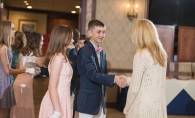It takes a lot to pry a teenager out of bed early on a Saturday morning. But Lauren MacDonald will be up with the sun because that’s one of the only times she can connect with Siyu Chen, her friend who lives 14 time zones away in Hangzhou, China.
“I’d be sad to miss it because I like talking to her,” says MacDonald, who calls Siyu by her English nickname, Grace. “We’re pretty similar. We’re both book-nerdy and school-nerdy.” The students routinely video chat through a computer program called Skype. They compare notes on classes, school lunches and underclassmen.
“She is a crazy animal lover and an amazing lover of reading,” says Chen of MacDonald. Both girls were surprised to learn they share a love for fictional books like the Twilight series and I, Robot. “I saw books on her shelf that are also on my shelves,” MacDonald says.
The two students developed this friendship through a unique course offered at Minnetonka High School (MHS) that exposes students to international culture. The International Studies and Exchange program is only in its second year, but 70 Minnetonka students are e-mailing, Skyping and interacting with students in four countries.
“What’s great about the course is students get to see how other parts of the world view us and we get a better view of the world ourselves,” says MHS principal David Adney. “They learn what life is like outside of Minnetonka and outside of our country.”
Adney got the idea for the program while visiting Minnetonka’s sister school in Hangzhou, China, in January 2009. When he came back to the district, he brainstormed ideas with three teachers who had international experience. The teachers believed living or studying overseas helped them grow as people, so they became passionate about students making a global connection, too.
“We didn’t have anything to model,” says Tim Laughinghouse, who teaches Current World Issues at MHS. “This was an opportunity to sit down and draw up what we’d like to see an international program look like.”
The class operates like an independent study course. Minnetonka students are matched with other students in China, Serbia, Russia and the Netherlands. They complete assignments outlined by their instructors on varying topics, like comparing schools or economic systems. Students connect individually, then meet monthly in small groups to compare notes, hear guest speakers and review assignments.
“The students’ eyes light up when they tell stories about the things they’ve learned from their partner,” he says. “They get a sense of how big the earth is, and how small it is as well.”
Minnetonka teachers have also developed a close relationship with the teachers in partnering schools so they can collectively develop assignments and check in on student progress. “It’s important for students to learn things outside of a classroom rather than a textbook,” says Guming Xia, instructor at Hangzhou Foreign Language School.
MHS teachers couldn’t agree more. They are currently pursuing schools in India and Chile to expand the program. “The real hope is using the technology on a regular basis over a longer period of time allows the student to make a concrete relationship,” Laughinghouse says.
It’s already happened with MacDonald and Chen. Both students initially thought the class was an interesting way to enhance their academic career. Somewhere in the middle of e-mail and Skype conversations, the girls discovered an easy camaraderie they both enjoy.
“I want to know about daily life in the USA and I’m eager to know how American teenagers speak,” says Chen, who hopes to possibly attend college in the U.S. one day.
MacDonald thinks her friendship with Chen could continue after the class ends in May. She sees it as just the beginning of a more globally connected world. “They are really just like us, so why not talk to them just as often as we might talk to other Americans?” said MacDonald. “We’re going to be talking to them for the rest of our life.”









